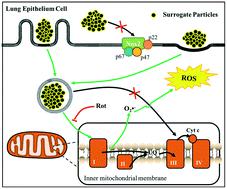当前位置:
X-MOL 学术
›
Environ. Sci.: Nano
›
论文详情
Our official English website, www.x-mol.net, welcomes your feedback! (Note: you will need to create a separate account there.)
The identification of the major contributors in atmospheric particulate matter to oxidative stress using surrogate particles
Environmental Science: Nano ( IF 7.3 ) Pub Date : 2021-1-6 , DOI: 10.1039/d0en01102a Keda Zhao 1, 2, 3, 4, 5 , Minjie Li 5, 6, 7, 8 , Lixia Zhao 1, 2, 3, 4, 5 , Nan Sang 5, 9, 10, 11 , Liang-Hong Guo 5, 7, 8, 12, 13
Environmental Science: Nano ( IF 7.3 ) Pub Date : 2021-1-6 , DOI: 10.1039/d0en01102a Keda Zhao 1, 2, 3, 4, 5 , Minjie Li 5, 6, 7, 8 , Lixia Zhao 1, 2, 3, 4, 5 , Nan Sang 5, 9, 10, 11 , Liang-Hong Guo 5, 7, 8, 12, 13
Affiliation

|
Oxidative stress is a unifying mechanism relating to the adverse effects induced by atmospheric particulate matter (PM). Owing to complex compositions, the role of PM constituents in triggering oxidative stress remains unclear. We employed synthetic particle suspensions with controlled sizes and compositions as PM surrogates to identify the key contributors to oxidative stress. The suspensions consisted of carbon black (CB) particles, polycyclic aromatic hydrocarbon adsorbed on CB, and dissolved metal ions. After the exposure of A549 or BEAS-2B cells to CB particles, the reactive oxygen species (ROS) level increased in a manner that was dependent on the size and concentration of the particles, in the order of 14 nm > 56 nm > 260 nm. Benzo[a]pyrene-coated CB also increased the ROS level, but not as much as the naked CB, and the benzo[a]pyrene-dione coating had no effect. The co-exposure of CB with one of the eight metal ions did not lead to any additional ROS increase. The results indicate that among the three major constituents, CB particles, and the small-sized ones in particular, contributed most to ROS generation. In mechanistic studies, damaged mitochondria cristae were observed, suggesting that mitochondria are one of the target organelles. Both naked and BaP-coated CB decreased the mitochondrial membrane potential and changed the mRNA expression of fusion/fission proteins. ROS inhibition experiments suggest that complex I of the mitochondria was involved, but complex III and the NADPH oxidase (NOX) system were not. It was thus postulated that small-sized particles could enter cells and disrupt the mitochondria, particularly complex I, leading to the elevated generation of ROS. Our work calls for more attention to be paid to the toxicity of the ultrafine fractions of PM.
中文翻译:

使用替代粒子识别大气颗粒物中氧化应激的主要因素
氧化应激是与大气颗粒物(PM)引起的不利影响有关的统一机制。由于组成复杂,PM成分在触发氧化应激中的作用仍不清楚。我们采用尺寸和成分可控的合成颗粒悬浮液作为PM的替代物,以确定导致氧化应激的关键因素。悬浮液由炭黑(CB)颗粒,吸附在CB上的多环芳烃和溶解的金属离子组成。将A549或BEAS-2B细胞暴露于CB颗粒后,活性氧(ROS)水平以取决于颗粒大小和浓度的方式增加,依次为14 nm> 56 nm> 260 nm 。苯并[ a涂有C的CB也提高了ROS水平,但不如裸露的CB和苯并[ a]py-二酮涂层没有效果。CB与八个金属离子之一的共同暴露不会导致任何其他ROS的增加。结果表明,在三种主要成分中,CB颗粒(尤其是小颗粒)对ROS的产生贡献最大。在机理研究中,观察到了破损的线粒体cr,表明线粒体是靶细胞器之一。裸露和BaP包覆的CB均可降低线粒体膜电位,并改变融合/裂变蛋白的mRNA表达。ROS抑制实验表明,线粒体的复合物I参与其中,而复合物III和NADPH氧化酶(NOX)系统则不参与。因此推测,小颗粒可以进入细胞并破坏线粒体,特别是复杂的I,导致ROS生成量增加。我们的工作要求对PM超细级分的毒性给予更多关注。
更新日期:2021-01-20
中文翻译:

使用替代粒子识别大气颗粒物中氧化应激的主要因素
氧化应激是与大气颗粒物(PM)引起的不利影响有关的统一机制。由于组成复杂,PM成分在触发氧化应激中的作用仍不清楚。我们采用尺寸和成分可控的合成颗粒悬浮液作为PM的替代物,以确定导致氧化应激的关键因素。悬浮液由炭黑(CB)颗粒,吸附在CB上的多环芳烃和溶解的金属离子组成。将A549或BEAS-2B细胞暴露于CB颗粒后,活性氧(ROS)水平以取决于颗粒大小和浓度的方式增加,依次为14 nm> 56 nm> 260 nm 。苯并[ a涂有C的CB也提高了ROS水平,但不如裸露的CB和苯并[ a]py-二酮涂层没有效果。CB与八个金属离子之一的共同暴露不会导致任何其他ROS的增加。结果表明,在三种主要成分中,CB颗粒(尤其是小颗粒)对ROS的产生贡献最大。在机理研究中,观察到了破损的线粒体cr,表明线粒体是靶细胞器之一。裸露和BaP包覆的CB均可降低线粒体膜电位,并改变融合/裂变蛋白的mRNA表达。ROS抑制实验表明,线粒体的复合物I参与其中,而复合物III和NADPH氧化酶(NOX)系统则不参与。因此推测,小颗粒可以进入细胞并破坏线粒体,特别是复杂的I,导致ROS生成量增加。我们的工作要求对PM超细级分的毒性给予更多关注。



























 京公网安备 11010802027423号
京公网安备 11010802027423号